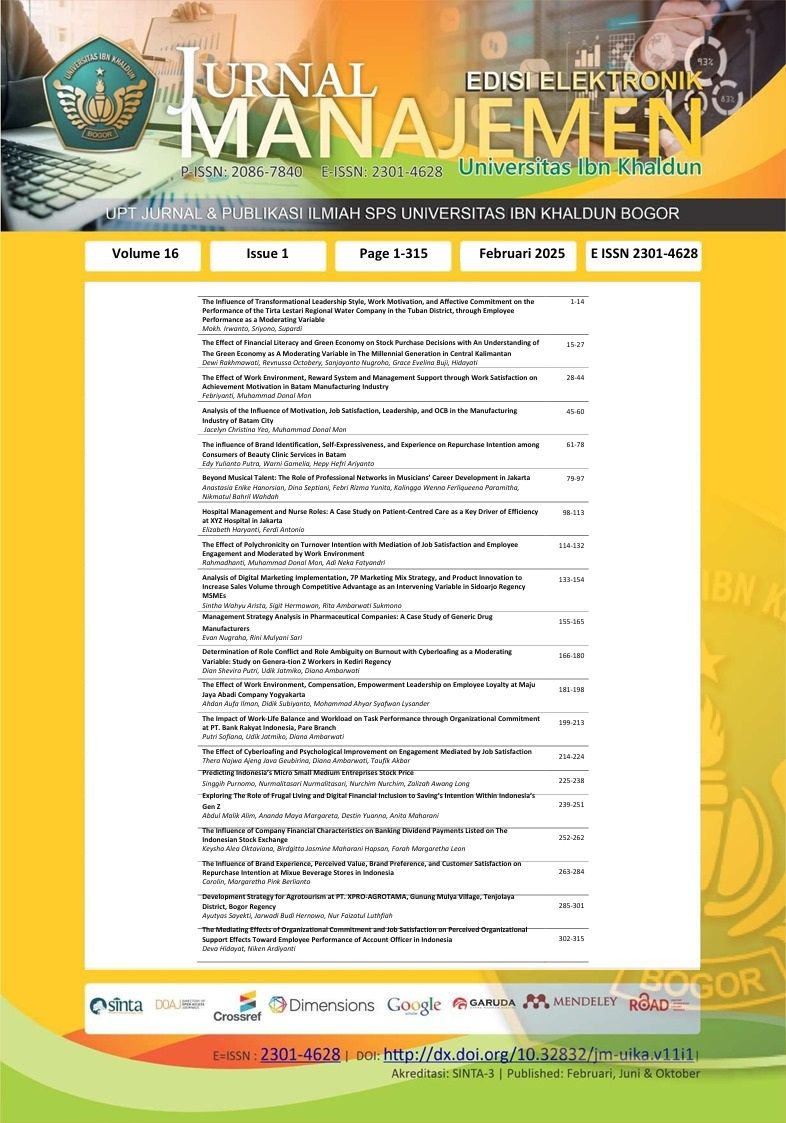Hospital Management and Nurse Roles
A Case Study on Patient-Centred Care as a Key Driver of Efficiency at XYZ Hospital in Jakarta
DOI:
https://doi.org/10.32832/jm-uika.v16i1.17920Kata Kunci:
Cognitive Empathy, Hospital Operational Efficiency, Quality Care, SEM-PLSAbstrak
This research investigates the influence of nurses' roles and responsibilities on hospital operational efficiency and the provision of quality care, emphasizing patient centred care as a crucial fac-tor. The study was conducted at a Type C private hospital in Jakarta, with data gathered from 208 nurses possessing over one year of experience. The analysis was performed using SmartPLS®4. The findings reveal that enhancing patient safety, employing evidence-based practice, fostering patient centred care, exhibiting positive interpersonal behaviour, and implementing clinical governance significantly improve hospital operational efficiency. Furthermore, cognitive empathy was found to moderate the effects of evidence-based practice and patient-centred care on operational efficiency, exhibiting both positive and negative impacts. The research indicates that hospital operational efficiency strongly affects the quality of care, with higher nurse perceptions being associated with better quality outcomes. The model demonstrated moderate to strong explanatory power and substantial predictive relevance, underscoring its efficacy in elucidating and forecasting quality care delivery through hospital operational efficiency. These findings underscore the necessity of integrating patient centred care and cognitive empathy into nursing practices to enhance hospital efficiency and the quality of care provided.
Referensi
Ahmed, S., Hawarna, S., Alqasmi, I., Ashrafi, D. M., & Rahman, M. K. (2023). Mediating role of lean management on the effects of workforce management and value-added time in private hospi-tals. International Journal of Lean Six Sigma, 14(5), 1035–1054. https://doi.org/10.1108/IJLSS-05-2022-0102
Altmiller, G. (2011). Quality and safety education for nurses competencies and the clinical nurse specialist role: implications for preceptors. Clinical Nurse Specialist CNS, 25(1), 28–32. https://doi.org/10.1097/NUR.0b013e318201f830
Andy, A., El-Hamzah, S. M. Z., & Antonio, F. (2022). Measures of Nursing Environment Multidi-mensionality and Patient Centricity Using Importance-Performance Map Analysis. Nurse Media Journal of Nursing, 12(3), 325–339. https://doi.org/10.14710/nmjn.v12i3.47508
Brunero, S., Cowan, D., Chaniang, S., & Lamont, S. (2022). Empathy education in post-graduate nurses: An integrative review. Nurse Education Today, 112, 105338. https://doi.org/10.1016/j.nedt.2022.105338
Chandrasekaran, A., Senot, C., & Boyer, K. K. (2012). Process Management Impact on Clinical and Experiential Quality: Managing Tensions Between Safe and Patient-Centered Healthcare. Manufac-turing & Service Operations Management, 14(4), 548–566. https://doi.org/10.1287/msom.1110.0374
Chen, Q., Gottlieb, L., Liu, D., Tang, S., & Bai, Y. (2020). The nurse outcomes and patient out-comes following the High‐Quality Care Project. International Nursing Review, 67(3), 362–371. https://doi.org/10.1111/inr.12587
Cleven, A., Mettler, T., Rohner, P., & Winter, R. (2016). Healthcare quality innovation and perfor-mance through process orientation: Evidence from general hospitals in Switzerland. Technological Forecasting and Social Change, 113, 386–395. https://doi.org/10.1016/j.techfore.2016.07.007
Cohen, J. (2013). Statistical Power Analysis for the Behavioral Sciences. Routledge. https://doi.org/10.4324/9780203771587
Donabedian, A. (1988). The quality of care. How can it be assessed? JAMA: The Journal of the Amer-ican Medical Association, 260(12), 1743–1748. https://doi.org/10.1001/jama.260.12.1743
Donabedian, A., Wheeler, J. R. C., & Wyszewianski, L. (1982). Quality, Cost, and Health: An Inte-grative Model. Medical Care, 20(10), 975–992. https://doi.org/10.1097/00005650-198210000-00001
Du, J., Huang, S., Lu, Q., Ma, L., Lai, K., & Li, K. (2022). Influence of empathy and professional values on ethical decision-making of emergency nurses: A cross sectional study. International Emer-gency Nursing, 63, 101186. https://doi.org/10.1016/j.ienj.2022.101186
Gamble, R. S., Henry, J. D., & Vanman, E. J. (2023). Empathy moderates the relationship between cognitive load and prosocial behaviour. Scientific Reports, 13(1), 824. https://doi.org/10.1038/s41598-023-28098-x
Hair, J., Hult, G. T. M., Ringle, C., & Sarstedt, M. (2022). A Primer on Partial Least Squares Struc-tural Equation Modeling (PLS-SEM).
Harimurti, P., Prawira, J., & Hort, K. (2017a). The Republic of Indonesia Health System Review Asia Pacific Observatory on Health Systems and Policies. In Health Systems in Transition (Vol. 7, Issue 1).
Harimurti, P., Prawira, J., & Hort, K. (2017b). The Republic of Indonesia Health System Review Asia Pacific Observatory on Health Systems and Policies. In Health Systems in Transition (Vol. 7, Issue 1).
Henseler, J., Ringle, C. M., & Sarstedt, M. (2015). A new criterion for assessing discriminant validi-ty in variance-based structural equation modeling. Journal of the Academy of Marketing Science, 43(1), 115–135. https://doi.org/10.1007/s11747-014-0403-8
Ilangakoon, T. S., Weerabahu, S. K., Samaranayake, P., & Wickramarachchi, R. (2022). Adoption of Industry 4.0 and lean concepts in hospitals for healthcare operational performance improvement. International Journal of Productivity and Performance Management, 71(6), 2188–2213. https://doi.org/10.1108/IJPPM-12-2020-0654
Jašková, D. (2021). Efficiency of management processes in a private hospital. Entrepreneurship and Sustainability Issues, 9(1), 436–446. https://doi.org/10.9770/jesi.2021.9.1(27)
Jeve, Y. B. (2018). Raising quality whilst reducing cost in health care: A retrospective cohort study. The International Journal of Health Planning and Management, 33(1). https://doi.org/10.1002/hpm.2454
Jia, Y., Yue, Y., & sheng, Y. (2023). Influencing factors of sense of responsibility among under-graduate nursing students: A cross-sectional study. Nurse Education Today, 130, 105938. https://doi.org/10.1016/j.nedt.2023.105938
Leana, C., Meuris, J., & Lamberton, C. (2018). More Than a Feeling: The Role of Empathetic Care in Promoting Safety in Health Care. ILR Review, 71(2), 394–425. https://doi.org/10.1177/0019793917720432
Liljas, A., Brattström, F., Burström, B., Schön, P., & Agerholm, J. (2019). Impact of Integrated Care on Patient-Related Outcomes Among Older People – A Systematic Review. International Journal of Integrated Care, 19. https://doi.org/10.5334/ijic.4632
Molina-Mula, J., & Gallo-Estrada, J. (2020). Impact of Nurse-Patient Relationship on Quality of Care and Patient Autonomy in Decision-Making. International Journal of Environmental Research and Public Health, 17(3), 835. https://doi.org/10.3390/ijerph17030835
Moreno‐Poyato, A. R., & Rodríguez‐Nogueira, Ó. (2021). The association between empathy and the nurse–patient therapeutic relationship in mental health units: a cross‐sectional study. Journal of Psychiatric and Mental Health Nursing, 28(3), 335–343. https://doi.org/10.1111/jpm.12675
Oldland, E., Botti, M., Hutchinson, A. M., & Redley, B. (2020). A framework of nurses’ responsibil-ities for quality healthcare — Exploration of content validity. Collegian, 27(2), 150–163. https://doi.org/10.1016/j.colegn.2019.07.007
Oldland, E., Hutchinson, A. M., Redley, B., Mohebbi, M., & Botti, M. (2021). Evaluation of the validity and reliability of the Nurses’ Responsibility in Healthcare Quality Questionnaire: An in-strument design study. Nursing & Health Sciences, 23(2), 525–537. https://doi.org/10.1111/nhs.12844
Prathibha Patel, M., & Ranjith, V. K. (2018). Moderating Influence of Efficiency on Variables of Hospital Financial Performance : Evidence from Indian Multi -Specialty Private Sector Hospitals. Indian Journal of Finance, 12(1), 9. https://doi.org/10.17010/ijf/2018/v12i1/120737
Ricca, R., & Antonio, F. (2021). THE IMPLEMENTATION OF CARE COORDINATION MODEL TOWARD DELIVERY OF QUALITY CARE IN PRIVATE HOSPITAL OUTPATIENT SETTING. Milestone: Journal of Strategic Management, 1(1), 41. https://doi.org/10.19166/ms.v1i1.3213
Sadeghi-Bazargani, H., Tabrizi, J. S., Saadati, M., Hassanzadeh, R., & Alizadeh, G. (2015). Nursing experiences of clinical governance implementation: a qualitative study. Clinical Governance: An In-ternational Journal, 20(4), 183–190. https://doi.org/10.1108/CGIJ-03-2015-0009
Samit, M., & Musheer Hussain, S. (2018). Clinical Governance and its Role in Patient Safety and Quality Improvement. In Scott-Brown’s Otorhinolaryngology Head and Neck Surgery (pp. 389–394). CRC Press. https://doi.org/10.1201/9780203731031-37
Sarstedt, M., Hair, J. F., Pick, M., Liengaard, B. D., Radomir, L., & Ringle, C. M. (2022). Progress in partial least squares structural equation modeling use in marketing research in the last decade. Psychology & Marketing, 39(5), 1035–1064. https://doi.org/10.1002/mar.21640
Sarstedt, M., Hair, J. F., & Ringle, C. M. (2023). “PLS-SEM: indeed a silver bullet” – retrospective observations and recent advances. Journal of Marketing Theory and Practice, 31(3), 261–275. https://doi.org/10.1080/10696679.2022.2056488
Sarstedt, M., Radomir, L., Moisescu, O. I., & Ringle, C. M. (2022). Latent class analysis in PLS-SEM: A review and recommendations for future applications. Journal of Business Research, 138, 398–407. https://doi.org/10.1016/j.jbusres.2021.08.051
Schein, E. H. (1990). Organizational culture. American Psychologist, 45(2), 109–119. https://doi.org/10.1037/0003-066X.45.2.109
Seo, J.-K., & Lee, S. E. (2022). Mediating roles of patient safety knowledge and motivation in the relationship between safety climate and nurses’ patient safety behaviors: a structural equation mod-eling analysis. BMC Nursing, 21(1), 335. https://doi.org/10.1186/s12912-022-01123-6
Slawomirski, L., & Klazinga, N. (2022). Health Working Papers The Economics of Patient Safety From Analysis to Action. http://www.oecd.org/els/health-systems/health-working-papers.htm
Suprapto, Y. M. (2023). The Influencing Factors of Customer Experience And Its Effect On Brand Equity In Seto Hasbadi Hospital Bekasi. Jurnal Manajemen, 14(1), 42. https://doi.org/10.32832/jm-uika.v14i1.8669
Tasi, M. C., Keswani, A., & Bozic, K. J. (2019). Does physician leadership affect hospital quality, operational efficiency, and financial performance? Health Care Management Review, 44(3), 256–262. https://doi.org/10.1097/HMR.0000000000000173
US Department of Commerce. (2023). Healthcare Resource Guide - Indonesia. International Trade Administration.
Vaismoradi, M., Tella, S., A. Logan, P., Khakurel, J., & Vizcaya-Moreno, F. (2020). Nurses’ Adher-ence to Patient Safety Principles: A Systematic Review. International Journal of Environmental Re-search and Public Health, 17(6), 2028. https://doi.org/10.3390/ijerph17062028
Venkataraman, S. (2015). Cost-Quality Tradeoff in Healthcare: Does it Affect Patient Experience? Quality Management Journal, 22(3), 38–45. https://doi.org/10.1080/10686967.2015.11918440
Wiknjopranoto, H. M., Linggar, B., & Nugraheni, Y. (2024). Opportunities, Challenges and Strate-gies in Implementing Indonesian Health Insurance Scheme: Case Study at a Hospital Class C. Jour-nal of Management and Business Environment (JMBE), 6(1), 61–87.
Yu, J., & Kirk, M. (2009). Evaluation of empathy measurement tools in nursing: systematic review. Journal of Advanced Nursing, 65(9), 1790–1806. https://doi.org/10.1111/j.1365-2648.2009.05071.x
Zoromba, M. A., & El-Gazar, H. E. (2021). Nursing Human Resource Practices and Hospitals’ Per-formance Excellence: The Mediating Role of Nurses’ Performance. Acta Bio-Medica : Atenei Par-mensis, 92(S2), e2021022. https://doi.org/10.23750/abm.v92iS2.11247
Unduhan
Diterbitkan
Cara Mengutip
Terbitan
Bagian
Lisensi
Hak Cipta (c) 2024 Jurnal Manajemen

Artikel ini berlisensi Creative Commons Attribution-NonCommercial 4.0 International License.
Authors who publish with this journal agree to the following terms:
- Authors retain copyright and grant the journal right of first publication with the work simultaneously licensed under a Creative Commons Attribution-NonCommercial-ShareAlike 4.0 International License that allows others to share the work with an acknowledgement of the work's authorship and initial publication in this journal.
- Authors can enter into separate, additional contractual arrangements for the non-exclusive distribution of the journal's published version of the work (e.g., post it to an institutional repository or publish it in a book), with an acknowledgement of its initial publication in this journal.
- Authors are permitted and encouraged to post their work online (e.g., in institutional repositories or on their website) prior to and during the submission process, as it can lead to productive exchanges, as well as earlier and greater citation of published work (See The Effect of Open Access).











